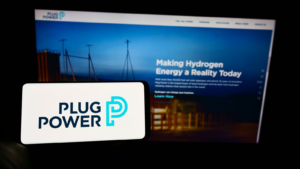Clean energy and renewable power solutions are key investment trends going forward. Undoubtedly, the world will continue to shift away from fossil fuels and toward green solutions over time. Hydrogen stocks will likely be one key part of this renewable energy future.
However, unlike wind, nuclear, or solar, commercial-scale hydrogen is still in the early stages of development. There are many high-risk hydrogen stocks out there because most firms are still in start-up mode and don’t have proven business models yet.
In addition, many business models around hydrogen need more infrastructure in terms of distribution and refueling points to achieve scale and commercial viability. As the technology is still in the early stages, hydrogen stocks are a higher risk area for now, and investors should be particularly cautious about these three firms.
Plug Power (PLUG)

Plug Power (NASDAQ:PLUG) is a classic example of a poor-performing hydrogen stock. The company has been publicly traded since the 1990s and has amassed a massive trail of failure and disappointment since then.
On a reverse-split adjusted basis, PLUG stock hit a peak of nearly $1,500 per share back in 2000, and the stock is down more than 99% since that point. Since its inception, Plug Power has racked up an accumulated deficit of $3.3 billion, which should give a sense of just how poorly it has allocated the shareholders’ hard-earned capital over the years.
With hydrogen stocks rallying again in recent years, traders have bid PLUG stock back up from its lowest levels. Unfortunately, the business remains in dire condition. For the full-year 2022, the company generated a negative 28% gross margin. That means for every $1 of revenue it generated, it costs $1.28 in materials simply to put those goods together.
Adding in other overhead, Plug Power racked up an operating loss of $658 million on revenues of $701 million. Simply put, Plug Power has disastrously bad unit economics and can seemingly only generate sales by virtually giving away its products. Since its inception, Plug Power has burned through more than $3 billion, and that figure will almost certainly continue to mount, given the company’s dismal profit margins.
Fusion Fuel Green (HTOO)
Fusion Fuel Green (NASDAQ:HTOO) is a recent European company that came to be through a special purpose acquisition company (SPAC). The company aims to provide hydrogen generators to clients who wish to run green hydrogen plants.
The problem is that there is little evidence of commercial demand for the company’s products. In its most recent quarter, Fusion Fuel Green generated a grand total of 580,000 EUR in revenues. That appears to be more of a glorified science project than a large commercial enterprise at this point.
With the share price declining, Fusion Fuel Green recently shook up its management team as well. The company is running low on cash and has resorted to using an at-the-market security offering to stay afloat. With seemingly endless dilution on the horizon and a lack of meaningful revenues, HTOO stock is likely to continue declining.
FuelCell Energy (FCEL)

Like Plug Power, FuelCell Energy (NASDAQ:FCEL) is another company that has existed for decades without developing products that it could sell profitability.
FuelCell has been publicly traded for more than 30 years. Shares peaked at more than $6,000 on a reverse split-adjusted basis during the dot-com bubble and now trade for around $2. It has had a total loss of $1.5 billion since its inception, all paid for with constant dilution of shareholders via endless secondary stock offerings.
FuelCell’s annual revenues are now lower than they were in 2013, and the firm generates a negative gross margin. A shrinking business that loses money on every unit it sells — that’s not a recipe for success.
There will likely be profitable, scalable hydrogen business models eventually. However, the examples of Plug Power and FuelCell, in particular, show the prior generation of technology hasn’t found a consistently profitable use case — yet. Investors should steer clear of these poor-performing hydrogen stocks until there is a meaningful change in the unit economics of the industry.
On the date of publication, Ian Bezek did not hold (either directly or indirectly) any positions in the securities mentioned in this article. The opinions expressed in this article are those of the writer, subject to the InvestorPlace.com Publishing Guidelines.

